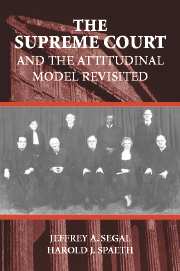Book contents
- Frontmatter
- Contents
- List of Illustrations
- List of Tables
- Preface
- 1 Introduction: Supreme Court Policy Making
- 2 Models of Decision Making: The Legal Model
- 3 Models of Decision Making: The Attitudinal and Rational Choice Models
- 4 A Political History of the Supreme Court
- 5 Staffing the Court
- 6 Getting into Court
- 7 The Decision on the Merits: The Legal Model
- 8 The Decision on the Merits: The Attitudinal and Rational Choice Models
- 9 Opinion Assignment and Opinion Coalitions
- 10 The Supreme Court and Constitutional Democracy
- 11 Conclusion
- Case Index
- General Index
8 - The Decision on the Merits: The Attitudinal and Rational Choice Models
Published online by Cambridge University Press: 05 June 2012
- Frontmatter
- Contents
- List of Illustrations
- List of Tables
- Preface
- 1 Introduction: Supreme Court Policy Making
- 2 Models of Decision Making: The Legal Model
- 3 Models of Decision Making: The Attitudinal and Rational Choice Models
- 4 A Political History of the Supreme Court
- 5 Staffing the Court
- 6 Getting into Court
- 7 The Decision on the Merits: The Legal Model
- 8 The Decision on the Merits: The Attitudinal and Rational Choice Models
- 9 Opinion Assignment and Opinion Coalitions
- 10 The Supreme Court and Constitutional Democracy
- 11 Conclusion
- Case Index
- General Index
Summary
In Chapters 2 and 3 we examined three models of Supreme Court decision making: legal, attitudinal, and rational choice. While there potentially may be any number of ways for rational choice theorists to model the decision on the merits, overwhelmingly, the most prominent application is the separation-of-powers model. We continue our look at the Court's decision on the merits with examinations of the attitudinal and separation-of-powers models.
THE ATTITUDINAL MODEL
Recall from Chapter 3 that the attitudinal model holds that the justices base their decisions on the merits on the facts of the case juxtaposed against their personal policy preferences. We thus examine the influence of case facts (or case stimuli), which are central to both attitudinal and legal models; attitudes, which are central only to the former; and the interaction between the two.
Facts
Case stimuli or facts are central to the decision making of all judges. Trial judges and juries must determine, for example, whether criminal suspects committed the deeds alleged by the prosecution. Appellate courts often must decide, based on the facts of the case as determined by the trial court judge and jury, whether the defendant's conviction was obtained in violation of the Constitution. Determinations of whether a given conviction or a given law violates constitutional rights necessarily depend on the facts of the case. Speaking out against the President is not the same as exposing nuclear secrets. Nor is libeling the President the same as libeling a private individual. Prohibiting abortion after conception is not the same as prohibiting abortion after viability.
- Type
- Chapter
- Information
- The Supreme Court and the Attitudinal Model Revisited , pp. 312 - 356Publisher: Cambridge University PressPrint publication year: 2002



